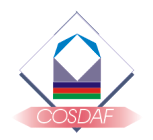Organic Light Emitting Diode
High-Efficiency Materials
There are a number of factors that determine the efficiency, driving voltage, lifetime and color of OLED displays, and organic functional material itself plays a major part of all. It is a well known fact that most of the blue organic materials suffer from short life time (~3000 hours for passive matrix OLED) while the red materials have a shortcoming of low efficiency. Therefore, the in-house synthesis of high efficiency fluorescent and phosphorescent materials, hole transport materials, electron transport materials are of our focus.

Progress of LED and OLED Materials
| Device | CIE (x,y) | Driving Voltage (V) @20 mA/cm2 | Current Efficiency(cd/A) | External Quantum Efficiency (%) | Lifetime T50@1000 cd/m2 (h) | Source | |
|---|---|---|---|---|---|---|---|
| Blue | Typical | < 0.15; < 0.20 | 5 ~ 8 | 2 ~ 5 | < 4% | < 3,000 | |
| World Record | 0.13; 0.20 | > 7.5 | 7.9 | ~ 17,000 | SID'06 Digest | ||
| Kodak | 0.142; 0.185 | < 4.0 | 11.0 | 8.05 | ~ 5,000 | SID'06 Digest | |
| UDC | 0.16; 0.37 | 20.0 | > 5,000 | ||||
| Green | Typical | < 0.35; > 0.65 | 5 ~ 8 | 3 ~ 12 | < 4% | < 20,000 | |
| World Record | 0.29; 0.64 | > 7.5 | 20.5 | ~ 100,000 | SID'06 Digest | ||
| Kodak | 0.248; 0.654 | 3.7 | 30.0 | 8.45 | ~ 50,000 | ICEL-6 | |
| UDC | 0.34; 0.61 | 65 | 40,000 | ||||
| Red | Typical | > 0.64; < 0.35 | 6 ~ 9 | 3 ~ 5 | < 4% | < 50,000 | |
| World Record | 0.67; 0.33 | 4.1 @10 mA/cm2 | 11.4 | 9.4 | > 100,000 | SID'06 Digest | |
| Kodak | 0.659; 0.340 | 4.2 | 11.4 | 9.1 | > 100,000 | ICEL-6 | |
| UDC | 0.67; 0.33 | 12.0 | 30,000 | ||||
| Latest Development of Red, Green and Blue Materials. Those Synthesized by UDC are Phosphorescent Materials | |||||||
On the other hand, while many organic materials possess good properties for commercial applications, their properties can often be improved by mixing in nanomaterials to form a hybrid or nanocomposite material. Successful use of organic/nanomaterial hybrids has been demonstrated. For example, carbon nanotubes are dispersed into polymer to improve the conductivity of the polymer; while C60 derivatives are dispersed in polymer to enhance charge dissociation. These works clearly exemplify the advantages of organic/nanomaterial hybrid systems in offering properties unmatched by organic-only systems. CityU team has successfully prepared a great number of nanomaterials with different sizes, morphologies, and properties in large quantities, which we are taking advantage of our expertise in making conventional OLEDs and nanomaterials to fabricate OLEDs based on organic/nanomaterials composites. The nanomaterials in the composite can be used to enhance charge injection, charge conduction and color tuning.
So far, CityU has designed and synthesized more than 30 new organic (emitting and charge-transport) materials in which 8 of them have been filed or pending as US patent. Representative proprietary materials are listed below.
- White
- DPBI:PDBT [CityU's US patent no. 6,521,360]
- NPB:PVK:TAPC [Syn Metal 111-112, 39 (2000)]
- TECEB [Adv. Mater. 16, 1538 (2004)]
- BNA:perylene:DCJTB [Chem. Phy. Lett. 369, 478 (2003)]
- Red
- BDPMB and BNPPDC [CityU's US patent no. 6,833,202]
- pAAA [CityU's US patent application no. 10/391,265]
- TBDPP [Chem. Phy. Lett. 382, 561 (2004)]
- isophorone-based dopant [Chem. Mater. 15, 1486 (2003)]
- Eu(DBM)3 [Appl. Phys. Lett. 76, 67 (2000)]
- Green
- pNNA [CityU's US patent no. 6,613,458]
- DEDPPQ [CityU's US patent no. 6,861,162]
- 1H-pyrazolo[3,4-b]quinoxaline derivatives [J. Mater. Chem. 13, 1894 (2003)]
- Blue
- TBADN [Chem Phys. Lett. 397, 1 (2004)]
- BNA [Chem. Phy. Lett. 369, 478 (2003)]
- DPBI [Mat. Sci. Eng. B 65, 182 (2001)]
- Fluorine derivatives [Adv. Funct. Mater., 15, 1716-1721 (2005)]
- Ir(F2-mppy)3 [Appl. Phys. Lett. 88, 093510 (2006)]




